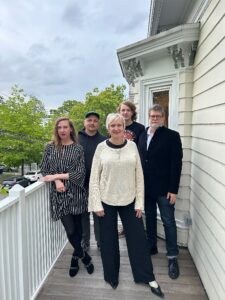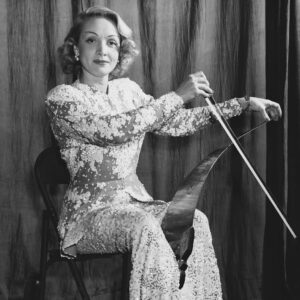Leigh Calabrese plays a Stradivarius — but not the kind you think. It’s a musical saw — a 32-inch flexible steel blade with sharp teeth and a wooden handle. The blade is engraved with the word “Stradivarius”: the brand name of the maker of the instrument, unrelated to the other, more famous Italian Stradivari.

Calabrese is a member of the Emberists, a band that will perform on Howland Lane during the first set of Wellfleet’s PorchFest, from 1:30 to 3 p.m. on Saturday, Aug. 23. This year is the festival’s tenth anniversary. The band also includes Mary McCarthy — known as Miss Mary Mac — on vocals, Michael McCarthy on fiddle, Malachi Connolly on rhythm guitar, David Kurimsky on lead guitar, and Benedict Dawn-Cross on drums and backing vocals. It was formed last year as the house band for a production of Max Frisch’s play The Arsonists, an absurdist satire about the rise of fascism before World War II, at the Chelsea Theatre Works near Boston.
The saw, whose mysterious history as a musical instrument offers no exact origin, sounds like the wind if it quit howling and learned opera: warbling and slippery with glissando. “It doesn’t have to be beautiful,” says Calabrese, “and often it’s not.” But often it is.
Calabrese, who lives in Gloucester, grew up in Rochester, N.Y. Before she played the saw, she took classical piano lessons for 10 years — the kind of instruction that led to annual recitals in living rooms. But she didn’t love it. “If you don’t enjoy it, how are you going to put in the effort and get good at it?” she asks. She left music behind for a while and in 1996 moved to Boston for a corporate job.
Shortly after starting that career, she thought, “This is not me.” She needed a creative outlet. Calabrese wanted to be onstage — and to find a niche in the Boston music scene. “I thought, the thing to do is to be the best in your category and make that category really, really small,” she says.
She’d seen footage of Marlene Dietrich, the German-American Hollywood star of the 1930s and ’40s, playing the musical saw. The instrument, with its vintage voice, was poised gracefully on the actress’s knee.

“Cool,” Calabrese thought. “Looks cool, sounds cool.”
She went to the Boston Public Library and found the only book there about how to play the saw. She doesn’t remember the title or the author. “It was probably in the self-help section,” she says. She checked it out, went to a hardware store, and said, “I’d like a saw.” She asked the man behind the counter to file down the teeth — a safety precaution for a beginner.
Once she was a decent player, she says, her husband gave her the Strad she plays now.
Armed with the saw, Calabrese has found gigs in wildly varying venues. She’s played lots of haunted houses, hidden behind curtains, making the saw sob and moan — the instrument uncannily emulates the sound of a person crying. She’s performed cabaret acts with the saw in which its sound becomes a gag. She’s done foley recording for soundtracks. Once, she performed as a solo musician for a wedding.
“The bride asked for ‘You Are My Sunshine,’ ” says Calabrese. “I think she wanted a spectacle.” The saw sang, pure and otherworldly.
Calabrese embraces the spectacle of the saw: with the handle held between her knees, she slides her horsehair bow vertically across the blade. Her left wrist snaps and bends as it manipulates the metal, moving the flexible steel up and down and allowing it to wobble, as if she’s drawing the sound in the air.
“There’s a sense of wonder to the instrument,” she says. “It has this quality of seeping into the aural corners of my brain. It’s a sound that I carry with me,” she adds, “even when I’m done playing. I hear it in my head.”
After the birth of her first son in 2005, Calabrese took a break from gigging. Now she’s back out there, but she has a day job: she’s a self-employed consultant and creative director, but not for anything to do with music. “I like health-care start-ups,” she says. These days, music is just for fun.
The saw isn’t for everyone. Calabrese’s younger son doesn’t care for it, although her older son likes it — she was pregnant with him when she was on tour in Florida with the band Beat Circus, playing all the time. “It imprinted on him,” she says. The instrument is unsettling; with its bent tones, it lends itself to improvisational wandering and doesn’t fit into the predetermined structure of some genres. It can’t exactly be played from a piece of sheet music.
The key, says Calabrese, is not to write music for the saw but “to write a piece that has space for saw.” The saw appears in Sarah McLachlan’s song “Last Dance,” from her 1997 album, Surfacing, in a delicate duet with the cello. It hides in the mix of the British rock band Supertramp’s song “Hide in Your Shell” and solos in Tom Waits’s song “November,” introducing the track with its alien cry.
At PorchFest, the Emberists won’t perform any original music. Instead, they’ll play covers of songs from the ’60s to the ’80s, “reinterpreted for whatever we are,” says Calabrese. “I’m not even going to try to name the genre of the band.”
Calabrese hopes the audience will react with curiosity: “Like, wow, that is a beautiful sound from space that you have brought to Earth.”
Been There, Saw That
The event: The Emberists perform at Wellfleet’s 10th annual PorchFest
The time: Saturday, Aug. 23, Set 1: 1:30 to 3 p.m.
The place: Howland Lane, Wellfleet
The cost: Free
